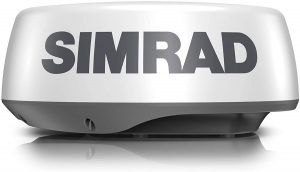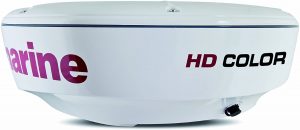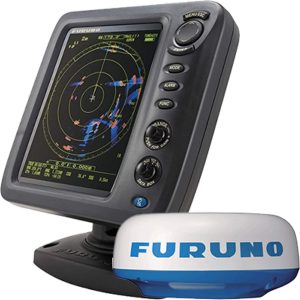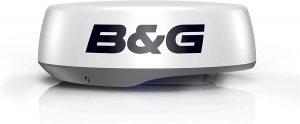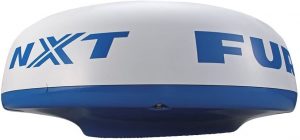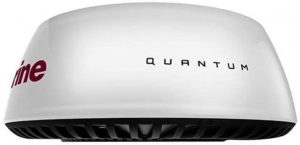Years ago, marine radars were only mounted on large boats operated by seasoned sailors. They used to be bulky and not always compatible with the average systems used on boats.
These days, even amateur sailors on smaller boats with relatively basic systems can easily avail of lighter, system friendly versions of marine radars to help avoid accidents and discern helpful targets (e.g., sea birds hovering over a shoal of fish).
A marine radar, combined with an electronic chartplotter employing updated digital charts and an Automatic Identification System, can be a vital component for a boatsman these days.
Our analysis below will help you find the best value for your money.
How to Choose the Right Marine Radar for You
Marine radars are vital in helping you navigate when visibility is low. You need to always be aware of your surroundings. Marine radars can show you objects more than 40 nautical miles away.
Choosing the right type of marine radar is stressful. There are many important factors to consider like the type of boat you are piloting, the technology being utilized and the specific use that you need to fulfill. Check out the table below to get a better understanding.
| Factors | Why It’s Important | Options |
| The Size of the Boat | Large sailboats with radar arches or pilothouses often employ “open array” radars with the rotating arms, while smaller boats often employ radomes that can be mounted inside a 1.5-2 ft. dome suitable to smaller spaces on small cruisers, sailboats or fishing boats. | Open array radars feature much wider antennas, very narrow beamwidth (1.1° to 3.5°), long ranges and the sharpest focus for picking out small targets. Radomes use less power, have fewer moving parts and can usually produce decent images with their beamwidths (3.5° to 7°). |
| Beam Width | The average beam width is 5.2°. | Narrow beamwidth denotes sharper delineation. However, narrow beams are more likely to miss smaller objects. |
| Range | In general, the distance to which a radar works is dependent on the height of your craft and the height of the target – allowing that a radar cannot see “over the horizon”. | Average range should be between 20-26 nautical miles. More powerful radars are 36-48 in range. Clarity is also key. Longer range radars may have difficulty with objects that are closer. |
| Power | The more powerful antennas have a better ability to pick up targets at longer distances and to cut through choppy weather. | Typical ranges:
2 KW – 20-24 nm 4 KW+ – 36-72 nm 25 KW – 96 nm. |
| Pulse vs. Solid State Radar | Pulse radars use old technology akin to microwaves. Solid state radars use broadband (Frequency Modulated Continuous Wave) technology. | Pulse technology is reliable. However, solid state is more modern and produces less radiation. They are also easier to install and warm up faster. |
| Mounting Kit and Technique | A good radar should come with a mounting kit and clear instructions. | Radars should be mounted above all obstructions to give it a clear 360 degrees view. |
| Use | The type of terrain and frequency of use can determine the type of radar you invest in. | If you frequently go on long sails and/or operate in choppy water, you need more powerful radars. |
| Compatibility with Other Technology | Good radars come with their own GPS and chart plotter, your boat may have installed technology. | Radar must be compatible with other technology already present on the boat. |
| Size and Weight | Small boats need smaller radars. Plus, you never want a heavy radar unit to be getting in the way. | The weight and size of the radar may be based on the space you have to operate. |
| Waterproofing | If you are frequently in choppy water, get a radar that can withstand frequent and potentially heavy splashing with water. | An IPX6 can withstand water. IPX7 through 9 will actually withstand temporary submersion. |
| Price | Prices could range from $1000 to well over $5000. | Bargains are fine, but a good radar could mean the difference between life and death. Value can be determined by frequency and type of use, but research any “value saver” option you buy. |
Recommendations
The choices below are varied, so it’s difficult to recommend a single model. Here are four models that stand out for different reasons:
Best Value for Money – Furono 8.4 Radar with Color Screen
Best Overall Technology – Furono DRS4D-NXT Solid State Doppler Radar
Best Detection Capability – B&G Halo24
Best Display – Garmin GMR 18HD+ Radome
Best Open Array Radar – Garmin 24 xHD
Best Marine Radars in 2023
1. Garmin 010-00960-00 GMR 24 xHD Radar
OVERVIEW – A powerful open array radar.
FEATURES
Range – 48 nautical miles
Antenna – 24” Radar dome
Transmitter – 4 KW
LCD – Color
Other Features – Dual (48 or 24 RPM) rotation speeds for fast screen refreshes; dual range auto adjustment as needed; advanced signal processing with Dynamic Sea Filter
OUR TAKE
This powerful, open-array radar features a high-definition display. Its dual rotation speed allows for fast screen refreshes and the unit auto adjusts based on range requirements. It’s easy to install and use and delivers clear images due to its advanced signal processing capabilities.
There are not many drawbacks reported on this model. There may be occasional problems with the display of uploaded photos but nothing major.
2. Simrad Halo20+ 20” Pulse Compression Radar
OVERVIEW – A high performance pulse compression radar with fast, live updates.
FEATURES
Range – 36 nautical miles
Antenna – 20” dome antenna
Transmitter – 25 watts
LCD – 20” display
Weight – 22 lbs.
Other Features – 60 RPM rotation at ranges up to 1.5 nautical miles, sweeping in a 360 degrees radius every second; Advanced Pulse Compression with Beam Sharpening; Velocity Track Doppler Technology
OUR TAKE
This radar features an industry leading 60 RPM rotation technology that operates at ranges up to 1.5 nautical miles, sweeping in a 360 arc every second to provide ultra-fast updates. The features are enhanced with the Simrad Halo’s velocity track doppler technology and the advanced pulse compression – all of which will keep the operator super safe from collisions with stationary and moving objects.
There are no real drawbacks reported except that it’s a bit pricey compared to some other models.
3. Raymarine RD418HD Digital Radome
OVERVIEW – This is a high powered radome antenna with great range, able to pick up objects as far away as 46 nautical miles/
FEATURES
Range – 48 nautical miles
Antenna – 18” radome antenna
Transmitter – 4 KW
LCD – 256 color multi-level target display with selectable color palettes
Weight – 21 lbs.
Other Features – Dual range mode for scanning far and near; compatibility with a, c and e series multifunction displays; adaptive digital receiver.
Accessories – 10 meter Raynet cable
OUR TAKE
This Raymarine model is a great value for money for both detection and display purposes. The adaptive digital receiver allows clear images during changes in sea and weather conditions. The dual range mode allows for scanning near and far, while the vivid color display allows you to spot almost anything clearly including birds.
The only drawback we find is as follows:
- Users may need to buy their own cables and adapters. The 30’ long cable can be unwieldy.
4. Furono 8.4 Radar with Color Screen
OVERVIEW – A reasonably priced radome with a 19” dome.
FEATURES
Range – 36 nautical miles
Antenna – 19” Radome antenna
Transmitter – 4 KW
LCD – 1815 Color Display Unit
Other Features –Variable antenna rotation speed, zoom, high resolution display.
Accessories – 10 meters cable
OUR TAKE
This recently released radar is more powerful than the Fuorno 1623, with color display and 36 mile nautical range. Reasonably priced, this unit consistently rates high among users for its value and performance – it does exactly what its meant to do at a reasonable price.
The only drawbacks we find are as follows:
- People may find the 30’ long cable to be a bit cumbersome.
- The unit is not networkable – for example, it won’t work with sonar.
5. B&G HALO24 24” Radar 000-14538-001
OVERVIEW – A recently released compact, pulse compression dome antenna radar that allows for dual detection and also long, mid and near distance scanning.
FEATURES
Range – 48 miles
Antenna –24” antenna
Transmitter – 4 KW
LCD – Color
Weight – 14.9 lbs.
Other Features – Ultra-fast updates with HALO24’s full 360 degree sweep every second, backed by its industry-first 60 RPM rotation at ranges up to 1. 5 nautical miles; dual-range mode; Velocity Track Doppler technology; MARPA target tracking
OUR TAKE
This ultra-lightweight but powerful dual speed radar provides ultra-fast updates with a 360 degree sweep every second, along with a 60 RPM rotation providing real-time views at close range. It works in dual range mode and provides high-resolution images (including bird spotting) at the low-, mid-and long-range. Its velocity tracker helps to detect whether objects are approaching or moving away. The unit wakes up instantly from standby mode.
The only drawback we find is as follows:
- Pulse compression is an older technology. Not much is known about the performance given that this is a new release.
6. Furono DRS4D-NXT Solid-State Doppler Radar
OVERVIEW – A solid state radar capable of delivering performance similar to an open-array radar while packed in a compact 24” dome.
FEATURES
Range – 48 nautical miles
Antenna – 24” Radome antenna
Transmitter – 25 KW
Beam Width – Furuno’s exclusive RezBoost™ Beam sharpening technology
LCD – Color display (green for hazardous objects,
Weight – 35 lbs.
Other Features – Pulse compression; Target Analyzer™; Fast Target Tracking™ utilizing Doppler technology; bird mode; compatible with some other systems
Accessories – 15 meters cable
OUR TAKE
This model is a powerful solid-state radar that delivers at an open-array level with a compact pulse compression technology. It’s many features include the Target Analyzer use, which identifies approaching hazards in red, while benign or stationary objects display as red. The Fast Target Tracking with Doppler technology can be shifted into bird mode if necessary. The model is easy to install and use and can stay within the dome.
The only drawback we find is as follows:
- The.15 meter cable may be cumbersome.
7. Garmin GMR 18HD+ 010-01719-00 Radome
OVERVIEW – A powerful 18-inch dome radar with clear echo definition.
FEATURES
Range – 36 nautical miles
Antenna – 18” Radar dome
Transmitter – 4 KW
LCD – Color
Weight – 17 lbs.
Other Features – Dynamic auto gain; advanced signal processing with Dynamic Sea Filter; radar overlay on chart plotter images
OUR TAKE
This dome radar features a high-definition display with advanced signal processing capabilities that provides clear echo definition at all ranges. It is also suitable for near range detection at 20 meters. The filter technology allows for clear images even during choppy seas, while the Dynamic Auto Gain technology allows the unit to overcome bad weather. You can add a MARPA capability. The overlay of radar images on a chartplotter map is an added bonus.
There are not many drawbacks reported on this model. The item is sometimes on backorder and not readily available.
8. Raymarine Quantam Radar (Wi Fi)
OVERVIEW – A solid-state technology radar with wi-fi capability that provides great detail with super low power consumption.
FEATURES
Range – 24 nautical miles
Antenna – 18” Radome antenna
Transmitter – 20 watts
LCD – 6” monochrome
Weight – 12.3 lbs.
Waterproof Rating: IPX6
Other Features – Advanced target separation; CHIRP pulse compression; enhanced short level detection
OUR TAKE
This is the lightest radar in our set, accompanied by the lightest power consumption. Its CHIRP pulse compression and advanced target separation capabilities ensure that each image is clearly defined. The unit delivers an industry leading level of short level detection at 18 feet.
There aren’t many drawbacks reported.
9. Furono 1623 Radar with 6” Monochrome Screen
OVERVIEW – A reasonably priced radome with a 15” dome.
FEATURES
Range – 16 nautical miles
Antenna – Tri-speed 15” Radome antenna
Transmitter – 2.2 KW
Beam Width – 6.5 degrees horizontal
LCD – 6” monochrome
Weight – 25 lbs.
Other Features – Guard zone, variable antenna rotation speed, zoom, VRM, EBL, echo trails, and Nav data display.
Accessories – 10 meters cable
OUR TAKE
This lightweight radar is suitable for smaller boats up to 17 feet. The 16-mile range radar will zoom down to 1/8 of a mile in tight spaces (e.g., harbor waters). The HD Sliver Bright LCD screen clearly demarcates targets and allows you to gauge stronger vs. weaker echoes. Targets can be displayed in a definition that stretches up to four levels of gray tones.
The only drawback we find is as follows:
- Users may find this model, which is superbly functional, to be a bit dated as far as its display capabilities go. Also, people find the 30’ long cable to be a bit cumbersome.
The Final Word
Radar technology, along with range, capability and convenience, has improved by leaps and bounds over the past decade. All the options mentioned here provide excellent value. You need to find out more about what fits your needs and budgets – but it’s hard to go wrong with these.

